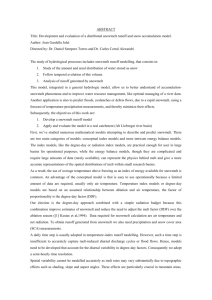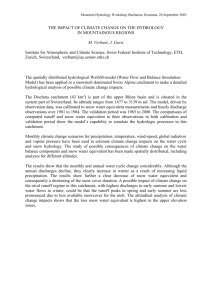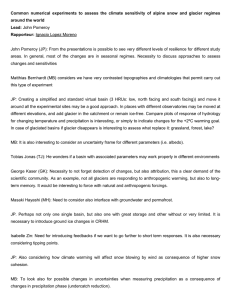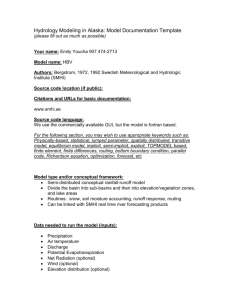The Use of Inductive and Deductive Reasoning to Model
advertisement
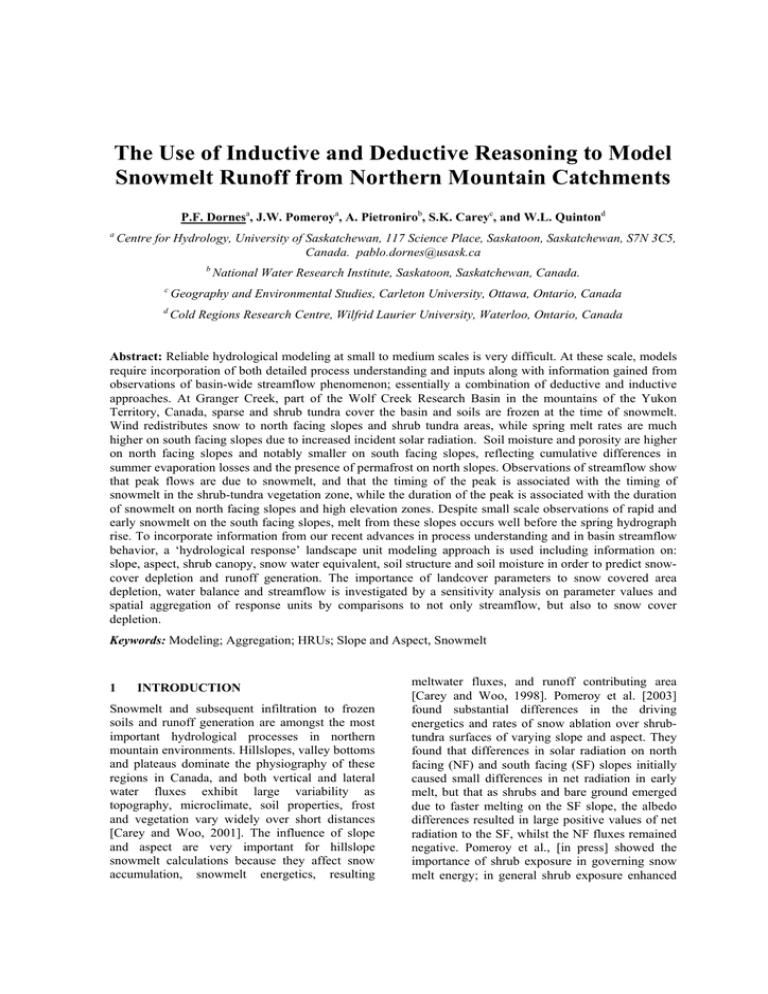
The Use of Inductive and Deductive Reasoning to Model Snowmelt Runoff from Northern Mountain Catchments P.F. Dornesa, J.W. Pomeroya, A. Pietronirob, S.K. Careyc, and W.L. Quintond a Centre for Hydrology, University of Saskatchewan, 117 Science Place, Saskatoon, Saskatchewan, S7N 3C5, Canada. pablo.dornes@usask.ca b National Water Research Institute, Saskatoon, Saskatchewan, Canada. c Geography and Environmental Studies, Carleton University, Ottawa, Ontario, Canada d Cold Regions Research Centre, Wilfrid Laurier University, Waterloo, Ontario, Canada Abstract: Reliable hydrological modeling at small to medium scales is very difficult. At these scale, models require incorporation of both detailed process understanding and inputs along with information gained from observations of basin-wide streamflow phenomenon; essentially a combination of deductive and inductive approaches. At Granger Creek, part of the Wolf Creek Research Basin in the mountains of the Yukon Territory, Canada, sparse and shrub tundra cover the basin and soils are frozen at the time of snowmelt. Wind redistributes snow to north facing slopes and shrub tundra areas, while spring melt rates are much higher on south facing slopes due to increased incident solar radiation. Soil moisture and porosity are higher on north facing slopes and notably smaller on south facing slopes, reflecting cumulative differences in summer evaporation losses and the presence of permafrost on north slopes. Observations of streamflow show that peak flows are due to snowmelt, and that the timing of the peak is associated with the timing of snowmelt in the shrub-tundra vegetation zone, while the duration of the peak is associated with the duration of snowmelt on north facing slopes and high elevation zones. Despite small scale observations of rapid and early snowmelt on the south facing slopes, melt from these slopes occurs well before the spring hydrograph rise. To incorporate information from our recent advances in process understanding and in basin streamflow behavior, a ‘hydrological response’ landscape unit modeling approach is used including information on: slope, aspect, shrub canopy, snow water equivalent, soil structure and soil moisture in order to predict snowcover depletion and runoff generation. The importance of landcover parameters to snow covered area depletion, water balance and streamflow is investigated by a sensitivity analysis on parameter values and spatial aggregation of response units by comparisons to not only streamflow, but also to snow cover depletion. Keywords: Modeling; Aggregation; HRUs; Slope and Aspect, Snowmelt 1 INTRODUCTION Snowmelt and subsequent infiltration to frozen soils and runoff generation are amongst the most important hydrological processes in northern mountain environments. Hillslopes, valley bottoms and plateaus dominate the physiography of these regions in Canada, and both vertical and lateral water fluxes exhibit large variability as topography, microclimate, soil properties, frost and vegetation vary widely over short distances [Carey and Woo, 2001]. The influence of slope and aspect are very important for hillslope snowmelt calculations because they affect snow accumulation, snowmelt energetics, resulting meltwater fluxes, and runoff contributing area [Carey and Woo, 1998]. Pomeroy et al. [2003] found substantial differences in the driving energetics and rates of snow ablation over shrubtundra surfaces of varying slope and aspect. They found that differences in solar radiation on north facing (NF) and south facing (SF) slopes initially caused small differences in net radiation in early melt, but that as shrubs and bare ground emerged due to faster melting on the SF slope, the albedo differences resulted in large positive values of net radiation to the SF, whilst the NF fluxes remained negative. Pomeroy et al., [in press] showed the importance of shrub exposure in governing snow melt energy; in general shrub exposure enhanced melt energy due to greater longwave and sensible heat fluxes to snow. Incorporating basin heterogeneity to better describe hydrological process within a hydrological model has lead to a number of methods of basin segmentation. However given the heterogeneity in the landscape hydrologists are still forced to conceptualize to some degree the physics and seek effective parameter values [Pietroniro and Soulis, 2003]. Distributed hydrological models use aggregation methods to account for landscape variability and processes representation; however a critical point in the application of these models is the selection of a landscape element size. The choice of a model resolution determines what variability can be explicitly and implicitly represented [Grayson and Blöschl, 2001]. Most snow energetics, snow hydrology, and snow-atmosphere interactions models still do not account for slope and aspect, solar angle and sky-view effects [Pomeroy et al., 2003] and their scale of influence, those that include these effects (e.g. Marks et al., [2002]) show substantial impact on the timing, area and duration of snowmelt. Recent research on hydrological processes in northern mountains has led to an improved process understanding (e.g. McCartney et al., in press; Sicart, et al., [2004]; Essery and Pomeroy, [2004]; Pomeroy et al., [2004]), however few studies have examined the spatial and temporal variability of processes and their applicability for runoff prediction at different scales. Therefore the goal of this paper is to investigate the effects of different physically-based model aggregations and parameterizations in describing the main hydrological processes affecting basin runoff during spring snowmelt. A ‘hydrological response’ landscape unit (HRU) modeling approach is used including information on: slope, aspect, shrub canopy, snow water equivalent, soil structure and soil moisture in order to predict snow-cover depletion and runoff generation. 2 STUDY AREA The study was conducted in Granger basin (60° 31’N, 135° 07W) which is located within Wolf Creek Research Basin, 15 km south of Whitehorse, Yukon Territory, Canada (Figure 1). The mean annual temperature is approximately -3°C, with monthly mean temperatures ranging from 5°C to 15°C in July and from -10°C to -20°C in January. The mean annual precipitation varies between 200 to 350 mm, with approximately 40 percent falling as snow [Pomeroy and Granger, 1999]. The geological composition of Granger basin is primarily sedimentary, consisting of sandstone, siltstone, limestone and conglomerate, overlain by glacial till ranging in thickness from centimeters to 10 meter. The presence of permafrost is determined by temperature and aspect, thus it is found under north facing slopes (NF-slopes) and in higher elevations, whereas seasonal frost occurs on the south facing slopes (SF-slopes). At lower elevation regions of Granger basin, soils are capped by an organic layer up to 0.4 m thick consisting of peat, lichens, mosses, sedges and grasses [Carey and Quinton, 2005]. The study area comprises and area of 8 km2 and four distinct landscapes according to their vegetation cover, soils and permafrost, slope, and exposure. Therefore, plateau area (PLT), NF and SF slopes and valley bottom (VB) are identified. Tall shrubs (1-2 m) are found in the valley bottom, with a mix of tall (1 m) and short (0.3 m) shrubs on the NF and SF and short (0.3 m) shrubs on the plateau. Moreover, the north-east oriented upper basin (UB) with similar characteristics to the NF slope and plateau area is included. Figure 1. Granger basin within Wolf Creek Research Basin. Circle and red line indicate the met station and measurement transect respectively. 3 SNOWMELT RUNOFF MODELING 3.1 Model description Various modules were assembled in the Cold Regions Hydrological Modeling System (CRHM) which is an object oriented program that permits the assembly of various hydrological observation, basin and process modules to create a purpose built hydrological model for a basin [Pomeroy et al., in press]. The Energy-Budget Snowmelt Model (EBSM) [Gray and Landine, 1988] for predicting snow ablation was applied. EBSM uses the snowmelt energy equation as its physical framework, and physically based procedures for evaluating radiative, convective, advective, and internalenergy terms from standard climatological measurements. Shortwave radiation terms for EBSM were corrected by slope and aspect. This correction algorithm calculates the theoretical interval short-wave direct and diffuse solar radiation from an expression proposed by Garnier and Ohmura [1970]. Snow-cover albedo is estimated assuming that the albedo depletion of a shallow snow cover, not subject to frequent snowfall events, can be approximated by three line segments of different slope describing the periods premelt, melt, and postmelt (the period immediately following disappearance of the snow cover) [Gray and Landine, 1987]. The change of internal energy (du/dt) of the snowpack is estimated using an algorithm that assumes a minimum state of internal energy determined by the minimum daily temperature, a maximum state equal to zero, a maximum liquidwater-holding content of the snow-cover equal to 5 percent by weight, a snow-cover density of 250 kg m-3, and no melt unless indicated by the model (For more details refer to Gray and Landine, 1988). During the spring snow melt frozen soil infiltration is estimated using the approach proposed by Granger et al. [1984] and Gray et al. [1986]. This module divides the soil into restricted, limited, and unlimited according to its infiltration characteristics. When limited, infiltration is governed primarily by the snow-cover water equivalent and the frozen water content of the top 30 cm of soil. The frozen infiltration routine is disabled when the SWE of the snowpack is less than 5 mm. Actual evapotranspiration is calculated using the algorithm of Granger and Pomeroy [1997], based on Granger and Gray [1989]. This algorithm does not require knowledge of soil moisture status, but uses the aridity of the atmosphere to index and ability to supply water for evaporation. Variations in soil moisture are accounted in the soil moisture balance module [Leavesley and Stannard, 1990]. The soil is handled as two layers. The upper layer is called the recharge layer and represents the top soil to which infiltration occurs. Evaporation can only occur from the recharge layer however transpiration is withdrawn from the entire soil depth. Surface infiltration satisfies the available storage of the recharge layer first before moving to the lower soil layer. Any excess water from both soil layers contributes to ground water flow before being discharged to the sub surface flow. Outflow (surface and subsurface runoff) from a HRU is calculated by lagging its inflow by the travel time through the HRU, then routing it through an amount of linear storage defined by the storage constant, K. 3.2 Observations and forcing data Meteorological measurements of air temperature, relative humidity, incoming solar radiation, and both wind speed and direction of the snowmelt period for 2002 (Apr to May) were used to force the modules within CRHM. Observations were made on the plateau area, whereas the precipitation data utilized were the observations made at the Whitehorse Airport. Areal snow water equivalent (SWE) was calculated from snow survey observations for each of the landscape units, such as plateau area, NF and SF slopes, and valley bottom. Snow surveys consisted of 120 points of a total of depth and 23 points of density measurement when snow-cover was continuous. 3.3 Modeling approach In order to evaluate the effects of different aggregation methods in modeling snowmelt ablation and runoff generation in a hillslope arctic environment, aggregated and distributed tiles were compared (Figure 2). In the aggregated model, all the landscape units (i.e. UB, PLT area, NF and SF slopes, and VB) were aggregated in a single and flat HRU. In this case initial boundary conditions (mean SWE, mean soil moisture), and forcing data (mean radiation) were weight-averaged according to the landscape units area (see Figure 2a). For the distributed analysis, the basin was split up in different HRUs according to the landscape units (see Figure 2b). Results were compared with distributed SWE observations. Moreover, these two modeling approaches allowed for comparing their effect in modeling basin discharge. 3.4 Parameters and initial conditions The aggregated model was initialised by computing the spatially weighted average values from each landscape. Therefore basin average values of elevation, SWE, albedo, and soil moisture were estimated. Calculated SWE values from available snow surveys were used to initialise the distributed model at NF and SF slopes, and VB HRUs. Initial SWE data at the PLT area was set from an available snow survey just before the snow melt season (Apr 18), whereas at the UB and since it is north-east oriented it was assumed a value of 180 mm which compromises characteristics of the NF slope and the PLT area. All HRUs were initialised with the same albedo value of 0.83. Model calibration was mainly performed on discharge data. Simulation of SWE did not require calibration in the aggregated model whereas the distributed model required very little calibration. In this case a melt delay parameter, in the EBSM module, of a few days was applied to NF and VB HRUs to adjust for mixed ablation and accumulation conditions. The basin discharge was calibrated by varying the same parameters for both the aggregated and distributed models. Therefore, the basin runoff hydrograph was calibrated by tuning routing parameters (K storage and Lag between HRUs) and soil parameters such as initial and maximum soil moisture and exchange of soil water excess to groundwater maintaining the overall water balance. Similar K values between HRUs but larger Lag values for NF and SF (late melt and high infiltration respectively) was the option chosen in the routing scheme. Max soil moisture values were similar for all HRUs except at the VB which was set up somewhat higher, whereas larger soil- groundwater exchanges were allowed at the SF, VB, and UP. Figure 2. Schematic representation of the basin. a) Aggregation of the different landscapes in one single and flat HRU, b) Distribution of the HRUs according to landscape units, and profile exhibiting differences in elevation and exposure among HRUs. Arrows indicate flow direction. As a result five and twenty five (considering the five HRUs) parameters were involved in the calibration of the aggregated and distributed models respectively. 4 RESULTS AND DISCUSSION 4.1 Ablation Figure 3 illustrates the observed and simulated snowpack ablation using the aggregated and the distributed representation of each HRU where snow survey data was available (NF and SF slopes, and VB). In general, SWE simulations during the ablation of the snow cover show a very good representation of both the evolution and the differential melt rates observed on each of the landscapes units considered with very little calibration (see section 3.4). Similar ablation rates than the observed spatiallyweighted average ( SWE ) values using the observations at the NF and SF slopes, and VB landscape units is seen at early stages of the snowmelt season for both the aggregated models and the distributed model by re-aggregating the results of the mentioned landscape units (Figure 3a). However, more substantial differences between modelled and observed are seen at late stages. The aggregated model shows more rapid depletion than the re-aggregated distributed model or the observations. Simulated SWE values at the NF slope (Figure 3b) show a close agreement with observed values during the main melt event in the middle of the melt season, however, differences at the beginning and at the end of the melt season are observed. This is attributed to episodic inputs of blowing snow to this HRU throughout the melt period, with substantial accumulation becoming apparent by the end of melt. This HRU is fed by blowing snow, even whilst other HRU are ablating [Pomeroy et al., 2003]. On the other hand, simulated values at the SF slope (Figure 3c) show a very good description of the observed evolution of the snow-cover ablation for the entire melt season is seen. On the VB (Figure 3d), lower modelled melt rates than the observed dominated the melt period, particularly in later melt. This is due to the progressive exposure of tall shrubs (2-3 m) which enhance longwave radiation and sensible heat to the snowpack and hence the melt rate [Pomeroy et al., in press]. This canopy effect is not considered in this model but will be in subsequent developments. 160 300 Obs SWE Aggregated Distributed 140 250 SWE [mm] SWE [mm] 120 100 80 60 200 150 100 40 50 20 0 4/15 4/22 4/29 5/6 5/13 5/20 5/27 6/3 Obs SWE NF Sim SWE NF 0 4/15 4/22 4/29 6/10 Time [days] (a) 5/13 5/20 5/27 6/3 6/10 Time [days] (b) 200 120 180 Obs SWE SF Sim SWE SF 100 Obs SWE VB Sim SWE VB 160 140 SWE [mm] 80 SWE [mm] 5/6 60 40 120 100 80 60 40 20 20 0 4/15 4/22 4/29 5/6 5/13 5/20 5/27 6/3 6/10 Time [days] 0 4/15 4/22 4/29 5/6 5/13 5/20 5/27 6/3 6/10 Time [days] (d) (c) Figure 3. Observed and simulated areal SWE values. a) Spatially-weighted basin-average using the NF and SF slopes, and VB observations, b) NF slope, c) SF slope, and d) Valley bottom. 4.2 Runoff Figure 4 compares the basin runoff values from the aggregated model and the distributed model against the observed values. 1.0 Discharge [m3 s-1] 0.8 Obs Aggregated Distributed 0.6 5 CONCLUSIONS 0.4 0.2 0.0 04/29/02 water balance using both approaches is seen. Even though the peak and runoff volume are properly estimated, the aggregated model shows a poor description of the runoff response, where differences in timing in the rising and falling limbs are observed. Conversely, the distributed model adequately describes the timing, peak, and volume of the observed basin runoff. 05/06/02 05/13/02 05/20/02 05/27/02 06/03/02 06/10/02 Time [days] Figure 4. Observed versus simulated basin discharges Both modeling approaches have a good overall performance with a Nash-Sutcliffe (R2) coefficient of 0.8 and 0.91 for the aggregated and distributed model respectively. Moreover, very good agreement between observed and simulated basin Effects of different aggregation methodologies in modeling snow-cover ablation and basin runoff for a small basin in a high latitude environment were evaluated. Basin segmentation was based on previous understanding of the hydrological response of the various landscape units. Using deductive reasoning for basin segmentation and inductive physical representation of the dominant hydrological processes, a reasonable simulation was possible. The distributed approach showed to be the one that best described the observed values of both snow-cover ablation and basin runoff. The aggregated approach on the other hand, could not properly represent the exposure effects in the duration of snow-cover ablation. Late stages of melt showed significant differences yet runoff volumes were still adequately represented. Timing differences in the rising and falling limbs of the, hydrograph for the aggregated case compared with those of the observed hydrograph were seen. Calibration was clearly simpler in the aggregated model, however very little effort based on deductive adjustments of the parameters and only for discharge data in the distributed model, allowed for a straightforward manual approach. Distributed models accounting for slope-aspect effects on snow accumulation, snowmelt energetics, resulting meltwater fluxes, and runoff contributing area, appears as the best methodology towards a development of regional snowmelt runoff models. Further investigations involving the comparison of for several years of observations and at various scales, and canopy effects will contribute to define a proper model scale for northern mountain environments. 6. REFERENCES Carey, S.K. and M.K. Woo. Snowmelt hydrology of two subarctic slopes, southern Yukon, Canada. Nord. Hydrol., 29: 331-346, 1998. Carey, S.K. and M.K. Woo. Spatial variability of hillslope water balance, Wolf Creek basin, subarctic Yukon. Hydrological Processes 15: 3113-3132, 2001. Carey, S.K. and W.L. Quinton. Evaluation of runoff generation during summer using hydrometric, stable isotope and hydrochemical methods in a discontinuous permafrost environment. Hydrological Processes 19: 95-114, 2005. Essery, R. and J. Pomeroy. Implications of spatial distribution of snow mass and melt rate for snow-cover depletion: theoretical considerations. Ann. of Glaciology 38: 735774, 2004. Garnier, B.J. and A. Ohmura. The evaluation of surface variations in solar radiation income. Solar Energy, 13: 21-34, 1970. Granger, R.J., D.M. Gray, and G.E. Dyck. Snowmelt infiltration to frozen prairie soils. Can. J. Earth Sci., 21(6):669-677, 1984. Granger, R.J. and D.M. Gray. Evapotranspiration from non-saturated surfaces. Journal of Hydrology, 111: 21-29, 1989. Granger, R.J. and J.W. Pomeroy. Sustainability of the western Canadian boreal forest under changing hydrological conditions. 2 summer energy and water use. In: Sustainability of water resources under increasing uncertainty. Rosjberg, D., N. Boutayeb, A. Gustard, Z. Kundzewicz, and P. Rasmussen (Eds.). IAHS Publ No. 240, IAHS Press, Wallingford, UK, 243-250, 1997. Gray, D.M., R.J. Granger, and P.G. Landine. Modelling snowmelt infiltration and runoff in a prairie environment. Proceedings of the Symposium: Cold Regions Hydrology, Fairbanks, Alaska, July, 1986. Publ: American Water Resources Association, 427438, 1986. Gray, D.M. and P.G. Landine. Albedo model for shallow Prairie snowcovers. Can. J. Earth Sci., 24(9): 1760-1768, 1987. Gray, D.M. and P. G. Landine. An energy-budget snowmelt model for the Canadian Prairies. Can. J. Earth Sci., 25(8):1292-1303, 1988. Grayson R. and G. Blöschl. Spatial modeling of catchment dynamics. In: Spatial Patterns in Catchment Hydrology. Observations and modeling. Grayson R. and G. Blöschl (Eds). Cambridge University Press. 404pp, 2001. Leavesley, G.H., and L.G. Stannard. A modular watershed-modelling system for use in mountainous regions: Schweizer Ingenieur und Architekt, 18: 380-383, 1990. Marks, D., A. Winstral, and M. Seyfried. Investigation of terrain and forest shelter effects on patterns of snow deposition, snowmelt and runoff over a semi-arid mountain catchment using simulated snow redistribution fields. Hydrological Processes,16(18):3605-3626, 2002. McCartney, S.E., S.K. Carey, and J.W. Pomeroy. Intra-basin variability of snowmelt water balance calculations in a subarctic catchment. Hydrological Processes (in press). Pietroniro, A. and E.D. Soulis. A hydrology modeling framework for the Mackenzie GEWEX programme. Hydrological Processes 17: 673-676, 2003. Pomeroy, J.W. and R.J. Granger. Wolf Creek Research Basin: Hydrology, Ecology, Environment. Environment Canada: Saskatoon, 160pp, 1999. Pomeroy, J.W., B. Toth, R.J. Granger, N.R. Hedstrom, and R.L.H. Essery. Variation in surface energetics during snowmelt in complex terrain. Journal of Hydrometeorology, 4(4): 702-716, 2003. Pomeroy, J.W., R.L.H. Essery, and B. Toth. Implications of spatial distributions of snow mass and melt rate for snow-cover depletions: observations in a subarctic mountain catchment. Ann. of Glaciology 38: 195-201, 2004. Pomeroy, J.W., D.S. Bewley, R.L.H. Essery, N.R. Hedstrom, T. Link, R.J. Granger, J.E. Sicart, C.R. Ellis, and J.R. Janowicz. Shrub tundra snowmelt. Hydrological Processes (in press). Sicart, J.E., J.W. Pomeroy, R.L.H Essery, J. Hardy, T. Link, and D. Mark. A sensitivity study of day time net radiation during snowmelt to forest canopy and atmospheric conditions. Journal of Hydrometeorology 5: 774-784, 2004.

